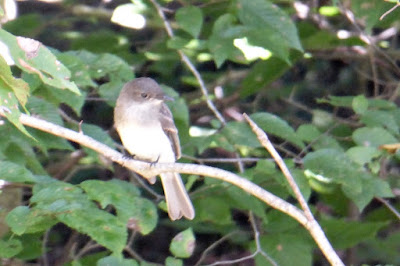On May 23rd Joan and I returned to Boch Hollow State Nature Preserve, this time at the East Trailhead,
to tread the paths we hadn't taken on our first visit. A short gravel path led towards the woods.
to tread the paths we hadn't taken on our first visit. A short gravel path led towards the woods.
Within ten minutes we saw this pair of flycatchers, variety undetermined (they're hard to tell apart except by song).
Shortly thereafter we entered the woodlands.Due to the heavy rains since last time, the paths had more frequent and larger muddy spots. Once Joan and I got a little water over the top of our boots crossing a creek, but nothing serious. Just muddy boots.
Most birds were, as usual, unwilling to pose. This is a murky shot of a female rose-breasted grosbeak.
After descending the first ridge and crossing a small creek we arrived at the cemetery. Many stones and blocks were unreadable; this, the largest, came closest. The first photo captures its natural colors under leaf-filtered light. (Click on the image to enlarge.)
I played with the contrast, edge detection, and other filters of the GIMP -- Gnu Image Manipulation Program -- and some portions were more legible, some still not.
A wonderful solo slump block, far from any companion formation.
More fire pinks, threatened with future obscurity by higher greenery than ten days ago.
Wonderful closeup of a showy orchis, now in full bloom.
A wood thrush.
Charming, diminutive long-spurred violet.
From the non-photosynthetic kingdom, a shelf fungus flourishing on a fallen log.
The unusual looking plant is the hairy/large-leaf waterleaf, but it's not blooming yet.
When the trail paralleled another low-lying area I spotted some movement almost on the ground. It was a bald-faced hornet! (The species is actually a yellowjacket wasp, not a true hornet.)
These eusocial beasties nest higher up in paper colonies, but this one was going round and around one of the thorns of a bush, less than a foot off the ground. We still haven't puzzled out what it was up to, unless it's chewing wood to expand the nest.
But the biggest treat by far came at the end of the hike. On the same trail we had entered by four hours before, a luna moth was snoozing on a trunk off the trail by bare inches. You must click on this one!
Joan and I count ourselves very fortunate as this large moth is nocturnally active and is in its adult stage, as here, for only 7 to 10 days. This one showed no signs of wear and tear, and must be quite young. We hope no-one, nor their dog, disturbed it the rest of the day.
Sidebar:
A disheartening behavior we commonly saw in these state nature preserves is people bringing their dogs. Pets are not allowed in the preserves, and the signs at the trailhead make this clear. The most charitable interpretation I can make is that they arrived without any knowledge of the rules, and then had a choice: go home, or break the rules. (I wouldn't condone leaving a dog in the car.) But most, I surmise, feel that their pets are so well behaved that it's OK. It is not. There are plenty of other parks where pets are welcome.





















































